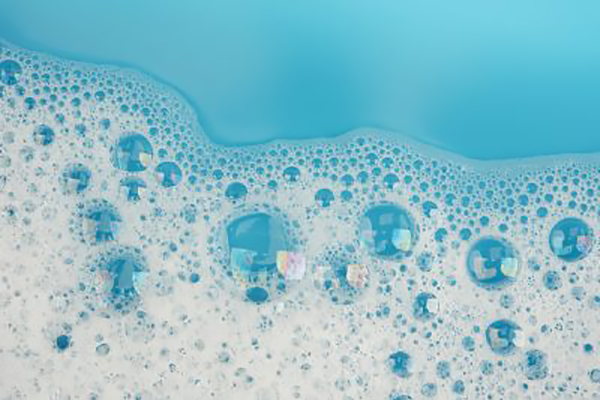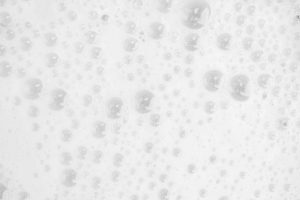 Defoamers are chemical additives that reduce and/or prevent the formation of foam in industrial process liquids. Anti-foam agents refer to materials that inhibit the generation and formation of bubbles. Dependent upon the application and performance requirements, they consist of polydimethylsiloxanes and other silicones, insoluble oils, stearates and glycols, as well as inorganics, such as silicates and talc.
Defoamers are chemical additives that reduce and/or prevent the formation of foam in industrial process liquids. Anti-foam agents refer to materials that inhibit the generation and formation of bubbles. Dependent upon the application and performance requirements, they consist of polydimethylsiloxanes and other silicones, insoluble oils, stearates and glycols, as well as inorganics, such as silicates and talc.
A defoamer is a surface active agent that breaks bubbles. Defoamers often refer to their activity during application processes. When discussing aqueous systems, it is necessary to consider water drainage. When water drains from the bubble it breaks. When water doesn’t drain, the bubble is more stable. The edge of each wall (called a plateau border in some geographical regions), is typically in the 50-125 of µm range. The plateau borders come together at nodes, which contain plenty of water.
The creation of foam and the size of the bubbles within that foam are more about complex physics than about surfactant science. To invoke some obvious general trends, that is, more air with more energy (greater turbulence or squeezing out of smaller orifices) gives more foam.
Bubbles can be incorporated by almost any methodology, and particularly with air-assisted spray by roller, and utilizing a foam brush. If the bubbles do not break quickly, there can be resultant film defects such as craters or pinholes. In colored systems, there can appear a color difference in a brush and roller-applied method because the small bubbles (microfoam) form a different surface and absorb light. There are many different types of defoamers that match to the chemistries (waterborne vs. solvent or solventless) as well as application and finish. Defoamer chemistry is constantly changing to follow substrates, VOC levels, and application. Many of the newer defoamers are reflective of the change in industry, going to either radiation curable or low solvent, low VOC systems.
The following two defoamers are relatively new and representative of just one company. BYK-1630 is VOC- and APEO-free Mineral Oil Defoamer for Aqueous Architectural Coatings. BYK-1630 contains some silicone to improve its effectiveness. BYK-1795 is a silicone-free polymer defoamer for solvent-borne, and radiation-curable systems. Excellent compatibility means that BYK-1795 can be used in a variety of applications. BYK-1795 has particularly good defoaming properties in polyurethane and epoxy-based floor coatings, in solvent-borne coil coatings (e.g., PVDF or polyester/melamine), as well as solvent-borne general industrial coatings and UV-curable systems.
It is fairly easy to say what will not be a good anti-foam (or defoamer or de-aerator). First, the anti-foam must be insoluble – either as oil or a particle; therefore anything soluble will not be a classic anti-foam. Noticeably, fatty-acid soap foam with soluble calcium will destroy the foam by insolubilizing the surfactant. What is the recipe for good anti-foam? The anti-foam must be insoluble. It must be in drop/particle form and it must be readily dispersible in the formulation in drops that are neither too big nor too small. Rather than relying on the visual appearance of microfoam, it is far easier to check the density of the finished coating. I have seen a coating that was very viscous (135 KU+) but had a density three quarters of a gallon less than theoretical. It can also affect the gloss reducing it drastically.

Microfoam makes depressing reading for those who want a guaranteed way to get rid of it in a coating. If you read the literature of suppliers of anti-foams, defoamers or de-aerators, they never promise magic solutions. By choosing a “poor” surfactant, we get unstable bubble walls.
A formulator should be aware that a laboratory test to screen defoamers may not be relevant to an application. If a wood coating with a strong defoamer is applied to a Leneta chart by brush, there may be instances of crawling or fisheyes. However, if the same coating is applied by foam brush, it may show sign of microfoam. Rather than adding a surfactant to improve the appearance of the coating as applied to a card, if the formulator utilizes the correct application methodology, additional cost and effect of the addition of a ‘corrective’ ingredient can be avoided.
Foam is a coarse dispersion of a gas in a liquid, where the volume fraction of gas is greater than that of the liquid. The bubbles will migrate to the surface as their density is less than that of the liquid. As the bubbles coalesce and collect at the air/surface interface, the bubble walls thin and break. Defoamers accelerate the process and break the smaller bubbles as well. Generally a defoamer is insoluble in the foaming medium and has surface active properties. An essential feature of a defoamer is the ability to spread rapidly on foamy surfaces.
In Mechanical dissipation of foam there is the following steps:
- Bubble consolidation, achieved with lower shear mixing that will put the microfoam in contact, especially at surface (vortex), and the foam will consolidate to larger bubbles that break more easily.
- Utilizing a very fine mist of water spray, the bubble walls will be disrupted and break.
- Utilizing vacuum products such as Rotovap or Ross Mill homogenizer, and vacuum.
- Vibration using a rotosieve to reduce the surface tension at the air/liquid interface in processes such as filtration of latexes.
Chemical defoamers similarly have analogous methods, in the form of composition rather than processes:
- Disrupt the bubble wall or cause increased drainage. In many cases, the choice of a chemical defoamer is a balance between highest efficiency and lowest undesired side effects, coupled with a preferred mechanical process; if available.
- In process, they can either consolidate small foam to larger bubbles which can then break at the air/liquid interface.
- Break bubbles during mixing and shear.
Heat aging is a quick way to evaluate long-term storage stability, usually done at intervals of one week for a total of 4 at 50°C; testing at each week. The other critical test is compatibility to ensure that the defoamer doesn’t interact or react with a component of the coating and cause seeding.
The views, opinions and technical analyses presented here are those of the author or advertiser, and are not necessarily those of ULProspector.com or UL Solutions. The appearance of this content in the UL Prospector Knowledge Center does not constitute an endorsement by UL Solutions or its affiliates.
All content is subject to copyright and may not be reproduced without prior authorization from UL Solutions or the content author.
The content has been made available for informational and educational purposes only. While the editors of this site may verify the accuracy of its content from time to time, we assume no responsibility for errors made by the author, editorial staff or any other contributor.
UL Solutions does not make any representations or warranties with respect to the accuracy, applicability, fitness or completeness of the content. UL Solutions does not warrant the performance, effectiveness or applicability of sites listed or linked to in any content.

 ) as the applications and development manager in Core R&D in the Coatings & Functional Polymers Group. He also managed the TS&D group for coatings while at Dow Chemical (1995-99) and held positions at Rhodia (Laboratory Manager, Latex & Specialty Polymers (1989-95)) and was the Development Chemist, exterior latex paints at Benjamin Moore & Co. (1979-89).
) as the applications and development manager in Core R&D in the Coatings & Functional Polymers Group. He also managed the TS&D group for coatings while at Dow Chemical (1995-99) and held positions at Rhodia (Laboratory Manager, Latex & Specialty Polymers (1989-95)) and was the Development Chemist, exterior latex paints at Benjamin Moore & Co. (1979-89).
Really its good technical information on Defoamer
GREAT ARTICLE VERY INFORMATIVE…… I JUST HAD ONE QUESTION HOW MUCH OF BUBBLES WOULD YOU SAY ARE CAUSED BY SQUEEGEE FRICTION IN SCREEN PRINTING APPLICATIONS
Thank you.
It depends. It really isn’t possible to say since unknowns are line speed, type of squeegee material, surfactant type and loading, temperature and humidity.
I work for a big box company and i was curious on a homemade remedy ( off the shelves) that i could mix myself and put in my floor scrubbing machines to break down foam
It’s really hard to use something that is a homemade remedy. If it’s a floor scrubbing machine and not a polishing machine it makes it a little easier. I realize that they just use different heads or 3M pads. Something like oil, like WD-40, which is fish oil based, or a cooking oil. You need very little. With the WD-40 you can actually spray it on the pad when you’re using it and it will knock down the foam. The problem is residual oil which may make the floor slippery